The following photo is from 1986, and shows the side of a building where the adjacent buildings have obviously been demolished. The building has “The House They Left Behind” painted in bold black letters on a white background, with below the original build date and a restoration date of the year before the photo was taken.
The same view today:
The House They Left Behind is still there, although the side of the building has been painted over. New homes have been built on the vacant space to the left.
Going back to the original photo, the sign on the street lamp on the left should give a clue as to the function of the building, the house they left behind was a pub, originally the Black Horse, but renamed as The House They Left Behind after all the adjacent buildings were demolished, mainly due to bomb damage from the war.
The building is in Ropemaker’s Fields, a short stub of a road that turns off Narrow Street in Limehouse, East London.
Unfortunately, my father did not take a photo of the front of the pub, only the signs at the side, however this is the front of the building on a sunny March morning.
I am not sure exactly when the pub closed, but it was auctioned off as a closed pub, and with planning permission for conversion to a home in 2009. The house was up for sale last year for £3.25 million.
In the 1986 photo, the sign on the side of the pub dates the build to 1857, however licensing records date a pub at the address to 1807, so the current building is a mid 19th century rebuild of the Black Horse.
It was adjacent to the Barley Mow Brewery, which was also located on a much longer Ropemaker’s Fields, which ran all the way to Three Colt Street. The 1894 edition of the Ordnance Survey map shows the location of the pub (red oval), Ropemaker’s Fields and the Barley Mow Brewery, which occupied a large area to the east. I have also marked another well-known Limehouse pub with a blue oval – the is the Grapes.
Credit: ‘Reproduced with the permission of the National Library of Scotland’
Today, Ropemaker’s Fields ends immediately to the east of the pub, and the green space with the same name, along with the housing estate alongside Barleycorn Way now occupy the area of the brewery, and the rest of Ropemaker’s Fields.
The name Ropemaker’s Fields give an indication of what the space here in Limehouse was used for. The following map is an extract from John Rocque’s 1746 map of London. The location of “The House They Left behind” is highlighted by the red oval. The street was named Ropemakers Fields in 1746, so this is an old street name.
If you look to the left and slightly higher from the red oval, there is a space called The Rope Walk.
A rope walk was a long space where lengths of rope would be made by twisting together the individual strands of material. The Rope Walk and Ropemaker’s Field indicate that this activity was carried out here in Limehouse, with a ready market for rope nearby from the ships docking along the river.
The 1746 map also shows that Narrow Street ended at the junction with Ropemaker’s Fields. The Fore Street was the road that continued on, however today Narrow Street now continues all the way to Three Colt Street and The Fore Street name has disappeared.
The following photo is a slightly wider view and shows where Ropemaker’s Fields would have once continued.
The 1746 map also shows an open space at the junction of Narrow Street and Ropemaker’s Fields. That open space remains today and at the corner, facing west is a large sculpture of a Herring Gull.
This was commissioned by the London Dockland Development Corporation in 1994 and created by the artist Jane Ackroyd.
The old pub is the only building that remains from the old Ropemaker’s Fields street. There is a single photo in the London Metropolitan Archives, Collage collection showing Ropemaker’s Fields. The following photo shows numbers 89 to 91.
Image credit: London Metropolitan Archives, City of London: catalogue ref: SC_PHL_01_397_1505
It is possible to precisely locate the above photo. The street name on the wall on the far left of the photo states Nightingale Lane. This lane ran north from the junction of Narrow Street and Ropemaker’s Fields, and if we look back at the 1894 Ordnance Survey map, we can see the bow-window of the first building, and the building that juts out a bit further into the street. I have circled these buildings in the map extract below. The pub would have been a short distance further along the street in the above photo.
Credit: ‘Reproduced with the permission of the National Library of Scotland’
Side view of The House They Left Behind, showing that whilst the building looks small from the street, it extends a long way back.
There are numerous mentions of the original pub name, the Black Horse, in newspapers. Mostly all the usual adverts for staff, use of the pub as an address for sales and auctions or meetings and inquests. In 1842 there was an inquest held in the pub on the sudden death of the landlady, from the Morning Post on Wednesday 11th May 1842:
“SUDDEN DEATHS – Three inquests were held last evening, by Mr Baker, on the bodies of persons who had died suddenly. The first took place at the Black Horse, Ropemaker’s-fields, Limehouse, on the body of Mrs Elizabeth Barton, aged 63, the landlady of the above house. Sophia Forest said that the deceased went out for a walk on Monday evening last, and returned home in good health and spirits at about half-past six o’clock. At about seven o’clock witness found her sitting in a chair in her parlour and quite insensible. She died at nine o’clock. Verdict, Natural death.”
Reading through old newspapers, competitive rowing on the Thames seems to have been a thing in the 19th century, with pubs often used in some form for the organisation of a race. Again, the Black Horse is mentioned a number of times in this context, and on the 2nd May 1858, Bell’s Life in London and Sporting Chronicle reported on once such challenge:
“CANNON AND WADE – In answer to Cannon’s challenge, Wade will give him two boat lengths start, and row him for £30 or £50 a side. Money ready on Thursday next at Mr Harass’s Black Horse, Ropemaker’s-fields, Limehouse. Since the above was in type Cannon called at our office, and expressed his willingness to proceed with the match; he deposited £2 10s in our hands, and will be at Mr Jones’s Ship, Church-street, Rotherhithe on Thursday next, prepared to sign articles and make it into £5 a side.”
With these competitions, there seems to often have been taunting of one party by the other, often seen as in the above competition by one person offering the other a head start, and a large amount of money. Presumably implying a low opinion of the other’s abilities.
A licence application in 1908 to the Clerk of the Licensing Justices of the Tower Division shows how the name of the pub and the pub sign was a real identifier of the pub, perhaps from a time when many people could not read, and signs were the visual identification of a place. The application finishes off “…. and which premises I intend to keep as an Inn, Ale-house or Victualing House under the sign of the Black Horse”.
The most recent mention of the pub is from 1998 when Christopher Dunhill, the heir to the Dunhill tobacco business was stabbed in the pub, with the landlord also being wounded. Dunhill had been living above the pub and was reported to be in a serious but stable condition at the time.
The Daily Mail reported that:
“The House They Left Behind is a stump of a pub that stands on a corner in
Limehouse, East London, isolated by Hitler’s Luftwaffe and subsequent
redevelopment. By closing time on Monday night there were only eight people in
the bar. Six left. Police are now asking them to come forward.
The two who remained were landlord Tony Fran, 32, and Mr Dunhill, 43, who
appears to have been lodging above the premises while running an oyster stall
on the small plaza outside. At around 11.30, three men carrying at least one
knife entered. Their intention was to murder both Mr Fran and Mr Dunhill.
They left in a dark-coloured car having failed, but only just.
Mr Dunhill had been stabbed 12 times in the head, neck and stomach. Last
night he was ‘stable’ in the Royal London Hospital. ‘He’s definitely on the
mend and should be out soon,’ said his brother Jonathan. But why would someone
want to kill Christopher? ‘I am not prepared to comment on that.’ Mr Fran
received wounds to his arms and buttocks and was discharged next day. He claims
to remember little of the attack.”
To the east of the pub is the green space, Ropemakers Field. This is looking along the space from the southern end, up towards the Limehouse Cut. The street, Ropemaker’s Fields once ran left to right where the shelter now stands.
On the opposite side of Ropemaker’s Fields to the pub is a triangular open space, then we find Narrow Street, with on the river side of the street, this historic Georgian terrace, which mirrors the scale of earlier 18th century development on the river.
At the western end of the terrace is the Grapes pub, the plaque on the pub claiming a 1583 date for a pub being at this location.
Further along the terrace are a mix of architectural styles representing the changing development of the buildings along the river’s edge:
The buildings provided the housing, workshops and warehouses that were needed to support the trade and industry on the river, just at the rear of these buildings.
Although the pub has gone, it is good that there is a single reminder of the buildings that once ran along Ropemaker’s Fields, so the name The House They Left Behind is still just as relevant.
The name of this short stub of a street also recalls one of the ship building and maintenance related industries that took place in the fields to the north.
Wapping Trivia
To finish off this post – a bit of Wapping trivia. The area to the east of London, both north and south of the river, was used as the backdrop for a number of films and music videos during the late 1970s and 1980s. I know films used east London in the preceding decades, but these were the years when I started taking an interest in these and their London locations.
I have been tracing and photographing the location of many of these for a future post, from Derek Jarman’s 1978 take on Punk in the film Jubilee through to music videos such as Katrina & The Waves and Walking On Sunshine from 1985, and it was locations from this later video that I was looking for when walking to Ropemaker’s Fields last Monday.
One of the locations has changed very little. This is a still from the video (available on YouTube), filmed in St John’s Churchyard next to Wapping High Street.
The same scene today:
Hardly changed in the last 25 years, although many other locations used in the video are very different now, or have been lost. More from this video, others and films in a future post.
To finish off, and show how wonderful London looks on a sunny spring morning, a view across St John’s Churchyard towards the church:

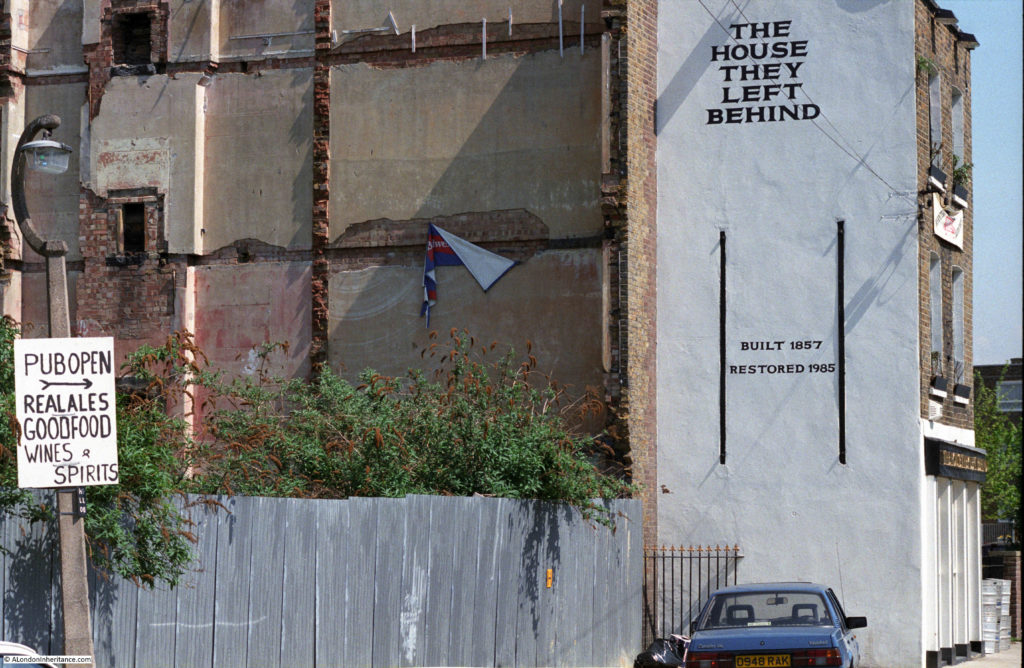
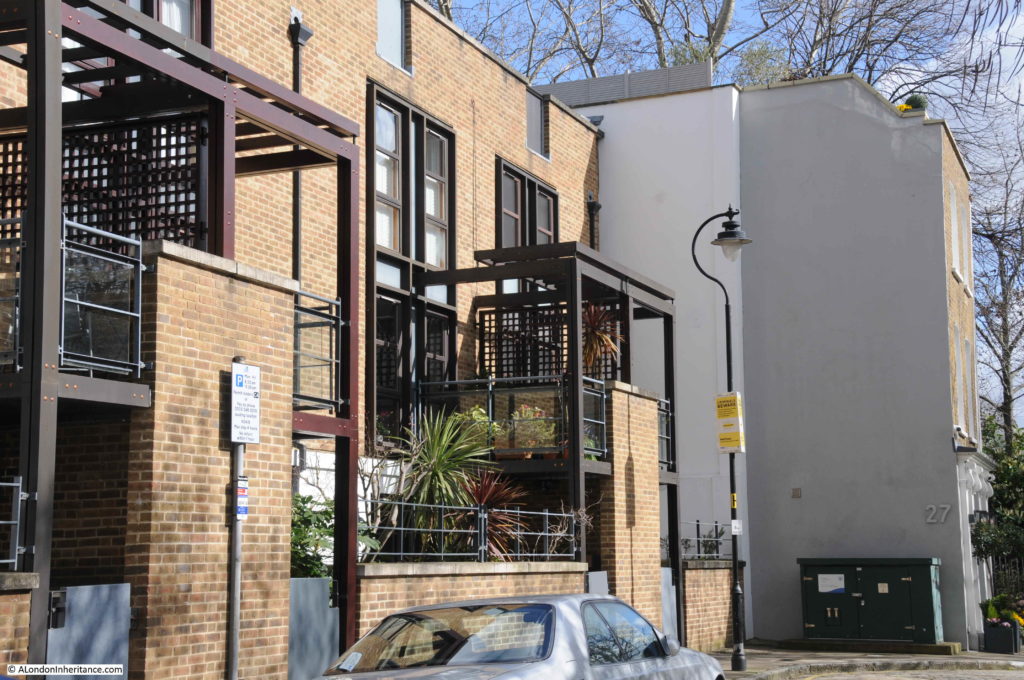





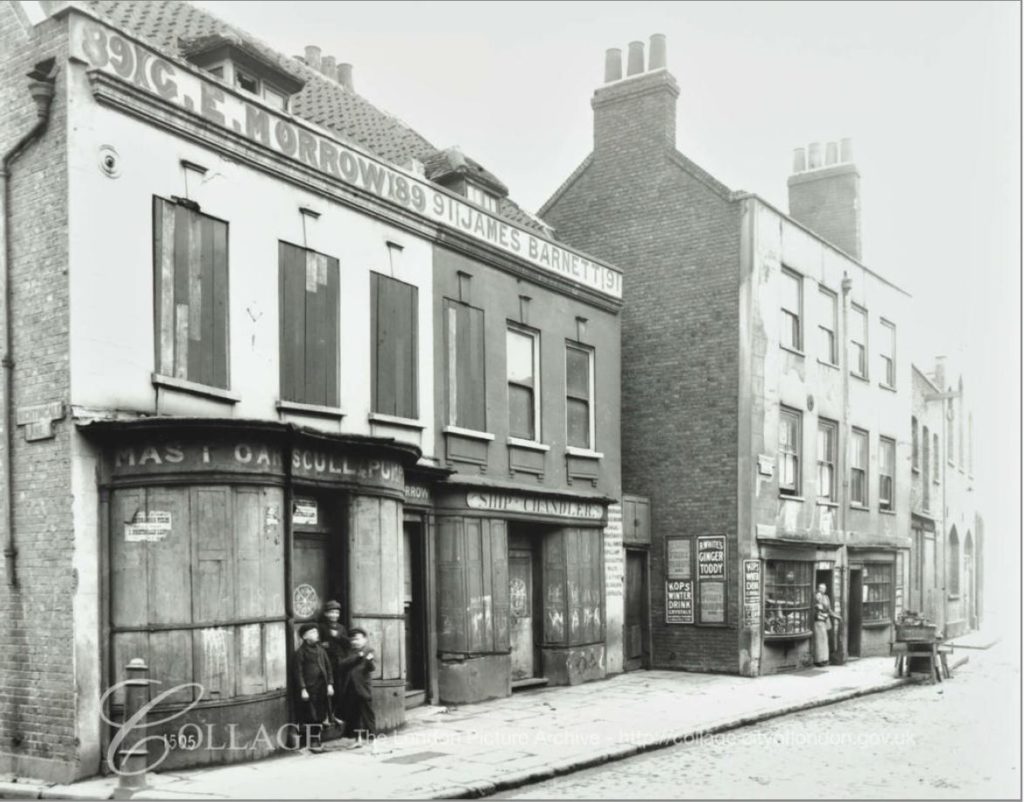
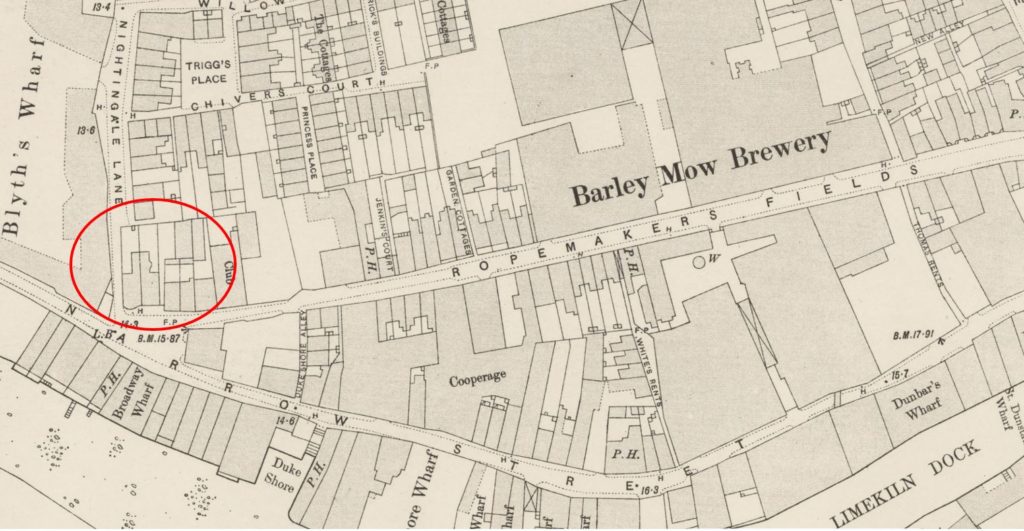





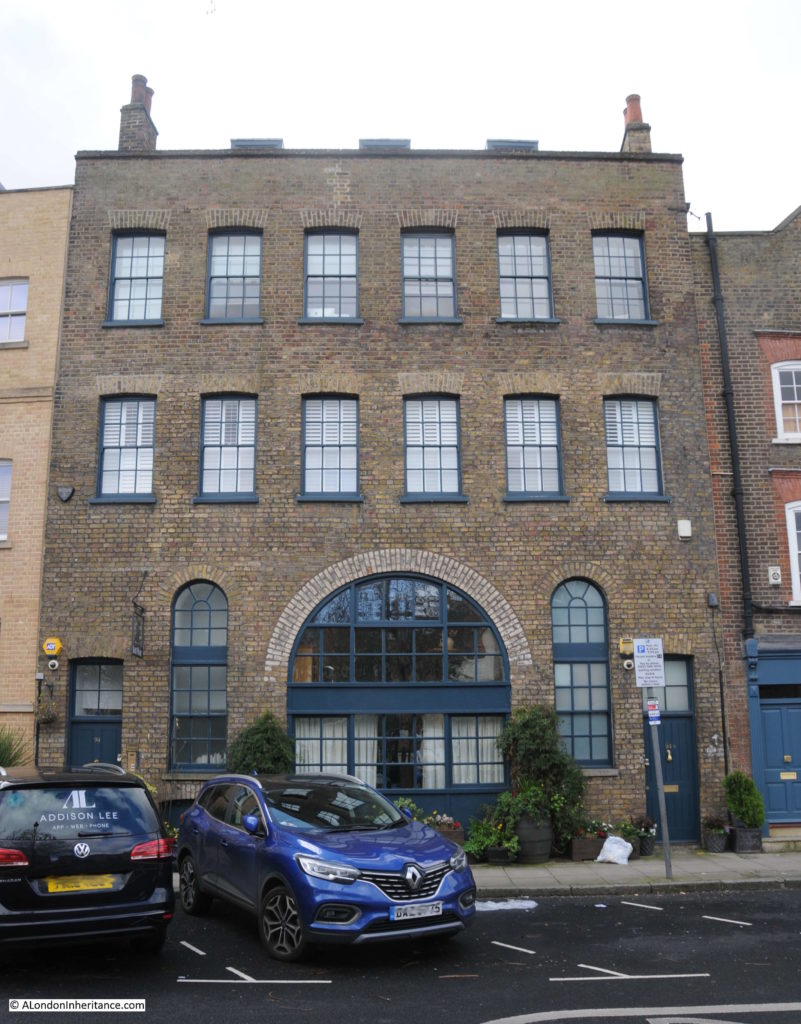


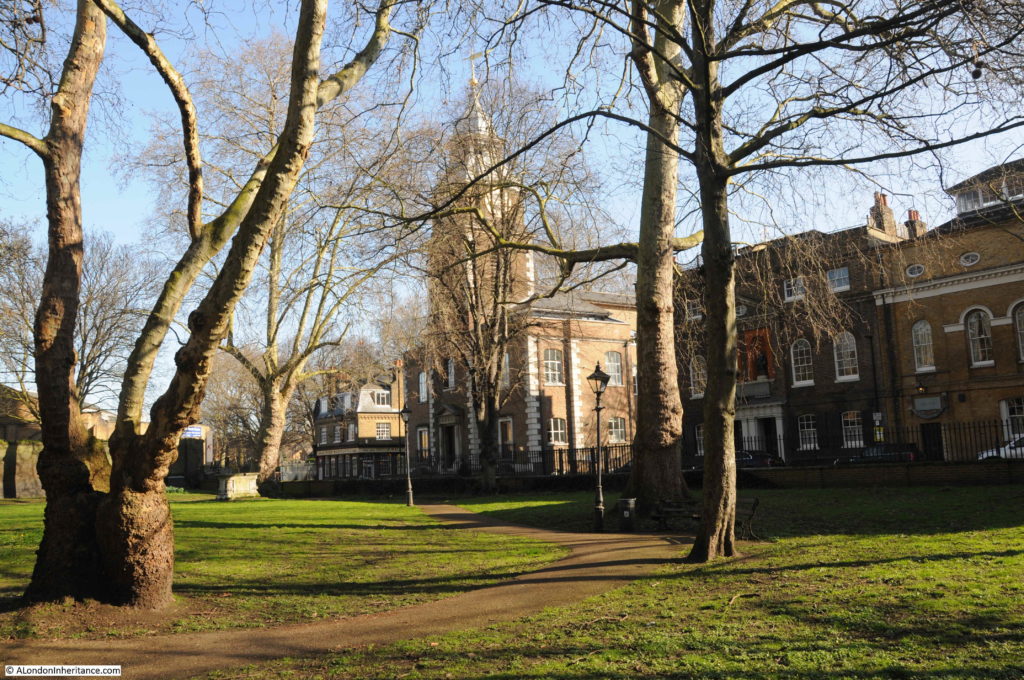
Fascinating, and such beautiful photographs. Make me nostalgic for another visit to London.. but not possible for a while I think. A double irony that the first photo says “Pub Open”. Not today, for any of us alas…..
Great post about Limehouse…the area is barely recognisable from when I worked there in the 1980’s…
so much open space and places for children to play. I don’t remember this pub, though my husband does..and will look for it when I am next there. The bridge over the Lime Kiln dock has made the Narrow Way much more accessible from the Isle of Dogs. Incidentally, “The Grapes” is meant to be the original for the pub called “The Six Jolly Fellowship Porters” in Dickens’ “Our Mutual Friend”.
Can anybody remember buntys pub we used to have a drink there on Thursdays after work . We used to work for the JC ” bb amec on building the tunnel from the highway to west ferry. We used to cross over the temp bailey bridge and look at the beautiful warehouses and drink at buntys a lovely chap and family. This was 1990/ 1993 when work was done we moved on
Great post as always, many thanks. Morrissey also filmed a video very close to the St John’s churchyard; https://m.youtube.com/watch?v=l6g0gDrCUi8 in the early 90’s. Growing up in Wapping I vaguely remember Jubilee being filmed, I think part of the Great Rock n Roll Swindle was also filmed nearby? Some local lads were used as extras, I was too young to be involved but a big fan of punk rock. I can also remember having at least one sports day in the graveyard as we called it! My father worked in Oliver’s Wharf which overlooked the churchyard, it was a tea warehouse up until the early 70’s.
I wonder who bought it? I hope not another foreign investor leaving it empty like so many in London now.
I bought it! I’m London born and bred and I very much do love my piece of history. I’ve loved this post and seeing the pictures.
Good news .
Hi Jodi, you bought The House they Left Behind, aka The Black Horse? That’s incredibly fun! My husband’s 3rd Great Grandfather owned it and in his will, bequeathed it to his grandson. I have loved reading the history on this place!
I remember drinking and eating there in the 90s/early 2000s and watched the only episode of big brother that I’ve ever seen there in 2000. Fond memories of the pub not so much big brother!
As always, a well reseached and interesting article. Thank you.
Here is one of my photos of the ‘House they left behind’ ( https://flic.kr/p/2dNa26h ) which also includes a link to a Metro article showing the internal refubishments and the tale behind them.
I live just round the corner. Moved here in Feb 2004 and it was open then, but must have closed very soon after, either later that year or sometime in 2005, I think? – The “Studio 92a” in one of your photos was also a pub at that time (can’t remember its name though), but it didn’t last much longer. Very glad Ian McKellen stepped in to keep The Grapes running when the landlady, Barbara stood down a few years ago. The Narrow (now a bar/restaurant) a bit further up the road was previously a pub, called the Barley Mow.
I’ve now got ‘Walking on Sunshine’ stuck on a loop in my head … happily not Morrissey!
Another fascinating article, thank you.
The film of “To sir with love” opening credits show Sidney Poitier walking out of Wapping Station. The author of the book, E R Braithwaite, taught at a school in Shadwell, I think it was the school in Cable Street. You can see an interesting plaque to Cable Street Schools from the gardens of St-George-in-the-east.
My paternal Grandfather was born and brought up at the top end of Cable street in the 1890`s when it was Brook Street. He went to school there. I have his leaving certificate from 1912.
Just like to say that I really enjoy reading your blog.
Keep the good work up.
Thanks for another very interesting post.
I look forward to these on a Sunday am –
‘A still point in a turning world’.
Just a short note from where I sit here in Boston USA, itching to get back to London to visit all the intriguing places in your wonderful weekly publications.
Your great photographs, eloquent writing and painstaking research are very much appreciated, especially in these trying times.
Thank you so very much!
Really enjoying your work as I was born & brought up in Poplar and Stepney – many memories are rekindled. Have you done any work on Speigelhalters in Whitechapel – I just love the whole ethos of the little man refusing to sell and sitting in the middle of the grand edifice?
I Love seeing the old streets and buildings, I am 73 and lived in stepney all my life,brings back some early memories Excellent,
Another great article – thank you
Another interesting read. Thank you.
Excellent read thank you
I’m thrilled I stumbled across your page. It is a fantastic site!!!! I’m in the process of mapping the history of London (among other places). My father grew up in Scotland during WWII. He has passed and I have no children. So, all the stories he shared with me will be lost unless I somehow capture what I remember (I know I have forgotten some and I know he didn’t tell me all). Creating maps of photographs of what once was and linking them to oral / written stories of our history is my goal. If anyone would like to share some special stories along with a photograph or a geographic locations, I would be happy to capture (email: heathertucker100@gmail.com). btw, I’ve been a geospatial advisor for a major O&G company for close to 30 years…so, my plan is to produce some decent web maps! Just curious how is everyone capturing stories and photographs to pass along to the next generation?
A brilliant read in these very troubling times a must visit area when hopefully things improve
What an interesting blog! I came across this page as I was trying to find out what had happened to the ‘Black Horse’ – I have a photo very similar to your first picture on this page, but taken by me in 1982, when it still had its original name. I was an art student, and spent some time around docklands taking colour slides for a college project. I’ll dig out my original and clean it up if you are interested?
Excellent article. Here’s some supplementary information. 92 Narrow Street was until circa 2012 ‘Booty’s Riverside Bar’ and prior to that ‘The Watermens Arms’.
I am researching my family tree and have found out that my grandmother was resident at 5 Northey Street (Limehouse) in 1861. At the time of marriage her groom’s father was by profession a Ropemaker, can you tell me the significance of Ropemakers Field and finally can you advise how I can find out more about this particular area.
Many thanks
Stewart
Great article, I just wanted to leave a comment to note that between the pub (in its later years simply called The House) closing and being refurbished as a family home, there was a brief time, probably around 2006, when it was a Malaysian restaurant called Melaka. It was pretty decent, I rather liked it
Thank you so much for this article! I found my husband’s 3rd Great Grandfather’s will. He owned the Black Horse Pub and bequeathed it to his grandson. As I write out our family history, may I reference your article and photographs? I’m in Canada, so hopping across the pond is a bit much to snap up photos or do hands-on research. 🙂
Just found one more picture of the front of The house they left behind in this document (Appendix 1)
https://www.nickwates.com/wp-content/uploads/2018/07/Limehouse-Petition-singles-Lo.pdf